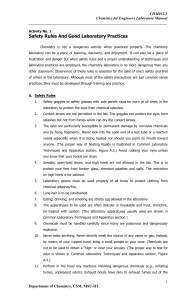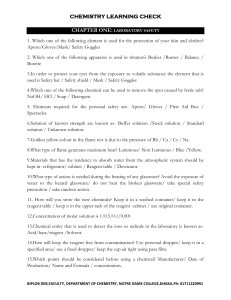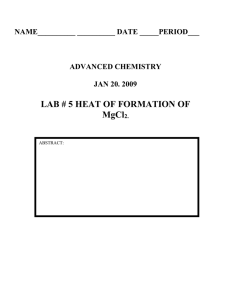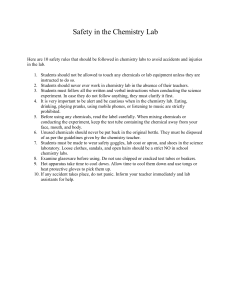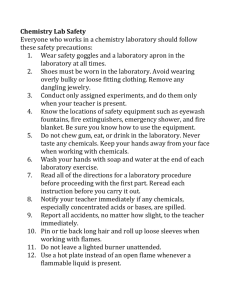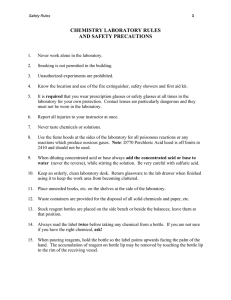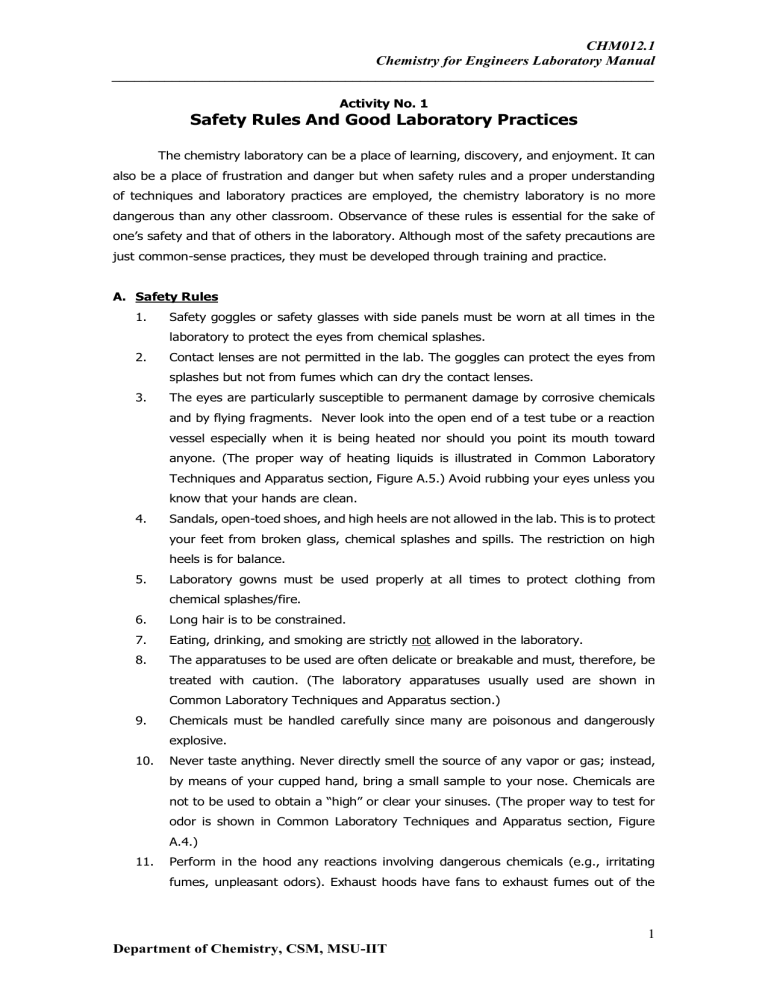
CHM012.1 Chemistry for Engineers Laboratory Manual ________________________________________________________________________ Activity No. 1 Safety Rules And Good Laboratory Practices The chemistry laboratory can be a place of learning, discovery, and enjoyment. It can also be a place of frustration and danger but when safety rules and a proper understanding of techniques and laboratory practices are employed, the chemistry laboratory is no more dangerous than any other classroom. Observance of these rules is essential for the sake of one’s safety and that of others in the laboratory. Although most of the safety precautions are just common-sense practices, they must be developed through training and practice. A. Safety Rules 1. Safety goggles or safety glasses with side panels must be worn at all times in the laboratory to protect the eyes from chemical splashes. 2. Contact lenses are not permitted in the lab. The goggles can protect the eyes from splashes but not from fumes which can dry the contact lenses. 3. The eyes are particularly susceptible to permanent damage by corrosive chemicals and by flying fragments. Never look into the open end of a test tube or a reaction vessel especially when it is being heated nor should you point its mouth toward anyone. (The proper way of heating liquids is illustrated in Common Laboratory Techniques and Apparatus section, Figure A.5.) Avoid rubbing your eyes unless you know that your hands are clean. 4. Sandals, open-toed shoes, and high heels are not allowed in the lab. This is to protect your feet from broken glass, chemical splashes and spills. The restriction on high heels is for balance. 5. Laboratory gowns must be used properly at all times to protect clothing from chemical splashes/fire. 6. Long hair is to be constrained. 7. Eating, drinking, and smoking are strictly not allowed in the laboratory. 8. The apparatuses to be used are often delicate or breakable and must, therefore, be treated with caution. (The laboratory apparatuses usually used are shown in Common Laboratory Techniques and Apparatus section.) 9. Chemicals must be handled carefully since many are poisonous and dangerously explosive. 10. Never taste anything. Never directly smell the source of any vapor or gas; instead, by means of your cupped hand, bring a small sample to your nose. Chemicals are not to be used to obtain a “high” or clear your sinuses. (The proper way to test for odor is shown in Common Laboratory Techniques and Apparatus section, Figure A.4.) 11. Perform in the hood any reactions involving dangerous chemicals (e.g., irritating fumes, unpleasant odors). Exhaust hoods have fans to exhaust fumes out of the 1 Department of Chemistry, CSM, MSU-IIT CHM012.1 Chemistry for Engineers Laboratory Manual ________________________________________________________________________ hood and away from the user. The hood should also be used when noxious, hazardous, and flammable materials are being heated. 12. Never pick up a heated piece of glass. If you must, use tongs, otherwise allow it to cool. 13. Sitting is not allowed while performing the experiment. Stools/chairs pose hazards by obstruction in pathways. 14. Do not sit on the laboratory tables. Pranks and horseplay, even when seemingly innocent, can cause serious injury and are, therefore, strictly forbidden. 15. Do not place personal items like bags, knapsacks, books on the laboratory desks because they take up valuable work space or may be damaged by fire or chemical spills 16. In case of fire due to gas leakage, immediately turn off the gas tank regulator. To prevent spreading of the fire, cover it with sand or wet cloth. 17. Experiments other than that required in the procedure are strictly not allowed. 18. Do not leave your experiment unattended. Fire, explosion, or any other accident may occur at this time. 19. The most common laboratory accidents are cuts from broken glassware or thermometer. Report breakage or damage immediately to the stockroom. 20. Most chemical spills are best handled by quickly absorbing wet material with paper towels and then washing the area with water. 21. Neutralize a spilled acid or base as follows: (a) acid on clothing, use dilute sodium bicarbonate solution; (b) base on clothing, use boric acid solution (50 g/L); (c) acid or base on the desk, use solid sodium bicarbonate for either, followed by water. 22. B. Report all injuries to the instructor for treatment. Good Laboratory Practices 1. Prepare for each experiment by studying it (both the Introduction and, briefly, the Experimental Procedure) and answer the Pre-Lab Assignment, if any, before you come to the laboratory. Completion and submission of the Pre-Lab Assignment is a requirement to perform the experiment. 2. Do not throw matches, litmus, or any insoluble solids into the sink. Labeled waste containers are provided to collect hazardous solid or liquid wastes. 3. Leave reagent bottles at the side tables and bring test tubes or beakers to obtain chemicals. 4. Read the label twice before taking anything from a reagent bottle; there is a lot of difference between the properties of 1 M H2SO4 and those of concentrated (18 M) H2SO4. 5. Avoid taking excessive amounts of reagent, 1- to 3 mL is usually ample for test tube reactions. 2 Department of Chemistry, CSM, MSU-IIT CHM012.1 Chemistry for Engineers Laboratory Manual ________________________________________________________________________ 6. Never return unused chemicals to the stock bottle. You may make a mistake that later will cause other students’ experiments to suffer. 7. Do not insert your own medicine dropper into the reagent bottles to avoid contamination. Pour only what you need into a small, clean beaker or test tube. (The proper way to pour liquids from a reagent bottle is shown in Common Laboratory Techniques and Apparatus section, Figure A.2.) 8. Do not lay down the stopper of a reagent bottle. It may pick up impurities and thus contaminate the solution when the stopper is returned. (Figure A.1 in Common Laboratory Techniques and Apparatus section show the proper way of opening a reagent bottle.) 9. Do not heat thick glassware such as graduated cylinders, volumetric flasks, or bottles; they break easily, and heating distorts the glass so that the calibrations are no longer valid. 10. All data should be recorded directly into your Answer Booklet, not on loose sheets or scraps of paper. 11. Good housekeeping is a prerequisite for safe and accurate experimentation. Keep your work table and the reagent table clean and tidy at all times. 12. The recommended procedure for cleaning glassware is to wash the object carefully with a brush in hot water and detergent, then rinse thoroughly with tap water, and finally rinse with a small amount of distilled water. Then allow the glassware to drain dry overnight in your locker. If you must use a piece of glassware while it is still wet, rinse it with the solution to be used. 13. You may discuss or argue your ideas and knowledge with your classmates, but don’t blindly copy their work. Do your own thinking and work and remember that integrity is the keystone to scientific work. 14. You may also find it useful to refer to your text while working in the laboratory. C. First Aid The following are common laboratory accidents that necessitate first aid treatment until professional help, if needed, is obtained. 1. Chemicals in the eye: Hold the eye open and immediately flush with water. Continue for at least 15 minutes. 2. Chemicals spilled on skin: Flush with large amount of water for 15 minutes. 3. Severe bleeding: Apply pressure or tourniquet. 4. Minor burns: Apply burn ointment which can be obtained from the stockroom. 3 Department of Chemistry, CSM, MSU-IIT CHM012.1 Chemistry for Engineers Laboratory Manual ________________________________________________________________________ Name : _________________________ Date : ________________ Section : _________________________ Score : ____________/30 Group Number: ___________________ Percentage : ______________% Activity No. 1 SAFETY RULES AND GOOD LABORATORY PRACTICES True or False (2 pts each) __________ 1. Contact lenses are permitted in the chemistry laboratory __________ 2. It is a good laboratory protocol to call the attention of other students when they are not practicing good laboratory safety procedures. __________ 3. An accident as simple as breaking a beaker containing distilled water in the sink does not need to be reported to the laboratory instructor. __________ 4. A beaker containing an acidic solution has broken on the table top and spilled onto your clothes from your waist down and it burns! You should immediately proceed to the safety shower and flood the affected area. __________ 5. Your friend is a senior chemistry major and thoroughly understands the difficult experiments that you are performing. Therefore, you can invite him/her into the laboratory for direct assistance. __________ 6. Prescription glasses can take the place of safety goggles in the laboratory. __________ 7. Cell phones, iPads, and other electronic equipment should be turned off during the laboratory period. __________ 8. You missed lunch but brought a sandwich to the laboratory. Since you cannot eat in the lab, it is alright to leave the sandwich in the hallway and then go in and out to take bites while the experiment is ongoing. __________ 9. All chemicals must be properly disposed either according to the Experimental Procedure or the laboratory instructor. __________ 10. Glassware is clean when no water droplets cling to the inner wall of the vessel. Write a brief answer for the following questions (5 pts each) 1. A chemical spill has occurred. What steps should be taken in treating the chemical spill? _____________________________________________________________________ _____________________________________________________________________ _____________________________________________________________________ 2. Describe how you will be dressed when you are about to begin an experiment in the laboratory. _____________________________________________________________________ _____________________________________________________________________ _____________________________________________________________________ 4 Department of Chemistry, CSM, MSU-IIT
